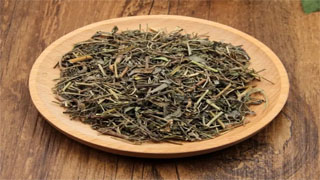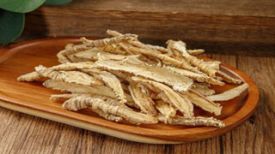
1. Aliases
Pearl bone penetrating grass, Jigai grass, goji fur grass.2. Plant morphology
Perennial herbaceous plant, 15-50 centimeters tall. Roots and stems running horizontally, light yellow brown in color; The stem is upright, clustered, and covered with gray white curly soft hairs. Leaves alternate or opposite at the base; Without a stem or with a short stem; The leaves are thick and papery, lanceolate to elliptically lanceolate, 1.5-7 centimeters long and 0.5-2 centimeters wide. The apex is blunt or gradually pointed, and the base is wide wedge-shaped or nearly circular. The upper part is entire, and the lower part has teeth. Both sides are covered with white pubescence. Racemes terminal; Flower unisexual homology; Male flowers are located in the upper part of the inflorescence, with 2 leaf shaped bracts and 1-3 flowers inside the bracts; Sepals 5, petals 5, scaly in shape, stamens 10-15, disk glands 5, yellow; The lower part of the inflorescence has slightly larger flowers, with one female flower in the middle and male flowers on both sides; Bracts 2; Female flowers have longer pedicels, 5-6 sepals, 6 petals, upper ovary, 3 styles, all 2-lobed. The capsule is triangular, flattened, and spherical in shape, covered with pubescence and warty protrusions, with the apex cracking; Each chamber has one seed, triangular obovate, green. The flowering period is from April to May, and the fruiting period is from May to June.
3. Origin distribution
Born on mountain slopes and grasslands. Distributed in North China, Northeast China, Jiangsu, Anhui, Shandong, Henan, Hubei, Hunan, Sichuan, Shaanxi, Gansu, Ningxia and other places. Mainly produced in Shandong, Henan, Jiangsu, Shanxi, Shaanxi, Gansu and other places
4. Harvesting and processing
Cut the whole grass with flowers and fruits on the ground in summer and autumn, and dry it in the sun.
5. Characteristics of medicinal herbs
The stem is multi branched, cylindrical or slightly angular, usually 10-30 centimeters long, with a diameter of 1-4 millimeters. Sometimes, the base of the stem is connected to some rhizomes; The surface of the stem is light green or grayish green, with a light purple color near the base. It is covered with grayish white pubescence and has alternating leaves or leaf scars. It is brittle and easy to break, with a yellow white cross-section. The length of the rhizomes varies, with a slightly rough surface of soil brown or yellow brown; The texture is slightly hard, and the cross-section is yellow white. The leaves are mostly curly, wrinkled or broken, appearing grayish green in color. Both sides are covered with white fine hairs, and the lower surface is more prominent near the leaf veins. Branches sometimes show racemes and inflorescences; Small flower shape; The capsule is triangular and flattened in shape. Mild in flavor and then slightly bitter in taste.
6. Nature, taste, and meridian tropism
Warm in nature and spicy in taste. Return to the Kidney Meridian and Liver Meridian.
7. Effect and function
Dispelling wind and dampness, relaxing tendons and promoting blood circulation, dispelling blood stasis and swelling, detoxifying and relieving pain. It belongs to the category of wind dispelling and dampness strengthening and bone strengthening drugs.
8. Clinical applications
Internal administration: decoction, 9-15 grams. External use: Boil water and smoke wash; Or tamp and apply. Indications include rheumatic pain, muscle and bone contractures, cold dampness and athlete's foot, lumbar sprains, paralysis, amenorrhea, scrotal eczema, sores and boils, and toxins
9. Pharmacological research
Tougucao has a wide range of pharmacological effects in pain relief, anti-inflammatory, antibacterial, and anti-tumor aspects.
10. Chemical composition
The above ground parts contain flavonoid components: vanillin, luteolin, naringenin-7-O-β - D - (3 "- para coumaroyl) pyranoside, naringenin-7-O-β - D - (4" - para coumaroyl) pyranoside, 3 ', 8 "- bis -4', 5,7-trihydroxyflavones. The whole plant contains pyridine alkaloids.
11. Taboos for use
Pregnant women should avoid using it.
12. Compatibility prescription
① Treatment of amenorrhea: 30g of bone penetrating grass root and 15g of madder grass. Boil in water, add brown sugar and yellow wine to make a drink. (Qingdao Chinese Herbal Medicine Handbook)
② For the treatment of rheumatoid arthritis and muscle and bone contracture: 9g of bone penetrating herb, 3g of Sichuan Aconitum and 3g of Grass Aconitum respectively, and 6g of stretch tendon herb. Boiled in water. (Selected Chinese Herbs from Shaanxi Gansu Ningxia Qing)
③ To treat injuries caused by falls, bruises, and pain: 9 grams each of Thorough Bone Grass, Madder Grass, Red Peony, and Angelica sinensis. Boiled in water. (Shanxi Chinese Herbal Medicine)
④ To treat leprosy and eczema all over the body: five coins each for bone penetrating herb, sophora flavescens, rhubarb, and realgar. Grind the powder and decoct the soup. Surround the banquet in the secret room, first smoke until sweat drips out, and then rinse it. (The Compendium of Materia Medica cites the Sun Family's Collection of Effective Prescriptions)
The content of the article is for clinical reference only. Non professionals in traditional Chinese medicine are not allowed to try medication.


